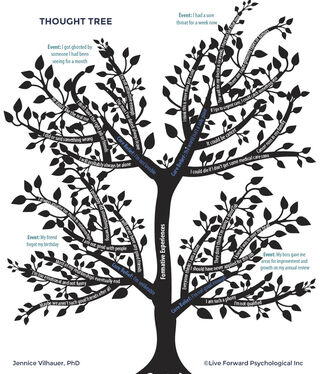Cognition
How to See the Blind Spots in Your Thinking
What you don't know can hurt you.
Posted December 29, 2020 Reviewed by Kaja Perina

Because we’re in our heads 24/7 we have a tendency to believe that what we think is true, and we have difficulty seeing the self-created paradigms through which we view our world. As a result, you have blind spots that at times prevent you from seeing things as clearly as you may need to, and you often don’t see the patterns of thinking that are holding you back from achieving what you want in life.
As a cognitive psychologist I spend a lot of time with my clients helping them learn to think about their own thinking, so they can see themselves with greater clarity and awareness, which allows them to make better choices.

In order to start to see your blind spots, the first thing to be aware of is that your inner thought world is constructed a lot like a tree. The trunk of the tree represents the foundation of your belief system and it was formed during early experiences in life.
For example, imagine a baby in a home where every time it cries, someone comes to pick it up, soothes it and tries to make it feel good. That baby is going to develop a certain set of expectations about whether the world is a nice place, will his/her needs get met, are people kind etc. Now imagine another baby in a different home where every time it cries, no one comes to pick it up. That baby will develop a very different set of expectations about whether the world is a nice place, will his/her needs get met, are people kind etc.
Think of the thousands of experiences that can happen even in the first few years of childhood when a child is learning about the environment and you start to see how your view of the world gets shaped.
From the trunk of the tree the big branches that hold the other branches emerge and these represent what is referred to as a set of core beliefs. Core beliefs are a person’s most central views about themselves, others, and the world. Examples of some common negative core beliefs include: I’m not good enough, I am unlovable, I am not safe in the world.
The top of the tree is where the events of life happen and the branches that flow down from the top of the tree are the thoughts you have about those experiences. The thoughts you have about an experience are never random. They are connected to your deeper core beliefs.
Another way to think about it is that these core beliefs serve as a lens through which every situation and life experience is seen. It’s a bit like having a pair of sunglasses on that you forgot you were wearing and then one day you lift them up and realize the world isn’t really that color. Your core beliefs serve as the lens that colors how you see and interpret the events in your life. It doesn’t mean the world really is that way, it just means based on your personal history, you developed certain beliefs that are shaping how you view the world.
This lens also serves as a selective filter, through which you collect evidence that matches up with what you already believe is true.
For example, if your core belief is, I’m not likeable, and you go to a party where 10 people say, It’s great to see you, and one person says, I didn’t think you would be here, you are likely to fixate on the one comment that matches up with your core belief and start a chain of thinking such as I wonder why he didn’t think I would be here, Did he think I wasn’t invited, I wonder if others thought I shouldn’t be there, Maybe the host only invited me out of obligation and didn’t really want me there, I knew I shouldn’t have gone. The other 10 people might as well not have existed because the only evidence that stuck was what was already consistent with the core belief and now the core belief has been reinforced and is stronger than ever.
Because your core beliefs are your lens for the world, if you’re unaware of what your core beliefs are, then you will have significant blind spots in your ability to think objectively and effectively about many situations.
A simple way to identify your core beliefs is to use a basic tool of cognitive therapy known as a thought record. I suggest creating 3 columns labeled as A, B, and C on a sheet of paper or in an excel file and track the events that trigger negative emotions for 30 days. It works for positive emotional events too, but most people don’t want to fix beliefs that create positive emotions, so you are looking to identify the ones you want to change.
In column A, list the Activating event or the event you are aware of. Then skip over to column C and write down the emotional Consequence of A. For example, if in column A the event is, your boss gives you a bad work review, then in column C you would write down how that made you feel such as angry or depressed. Then go back to column B and write down what it is you Believe to be true about A that led to the emotion you listed in column C.
A: My boss gave me a bad review B: I am being treated unfairly C: Angry
If you do this exercise for 30 days listing at least 4-5 events per week on the thought record, what you will find is that there will be lots of different situations in column A but the thoughts in column B will have similar themes that emerge, such as I’m not good enough. The themes that show up will reflect your core beliefs.
Once you are aware of your core beliefs then you are in a position to make choices about them and to work on getting rid of the ones that don’t serve you and creating new beliefs that are more effective for what you want and who you want to be in the world. If you do this exercise and find you still have trouble seeing the core patterns in your thinking, then I suggest working with a therapist that specializes in cognitive therapy who can help you.


